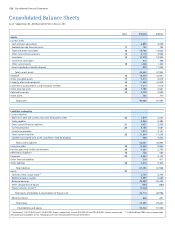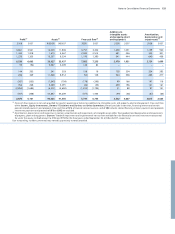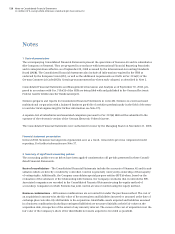Siemens 2008 Annual Report Download - page 224
Download and view the complete annual report
Please find page 224 of the 2008 Siemens annual report below. You can navigate through the pages in the report by either clicking on the pages listed below, or by using the keyword search tool below to find specific information within the annual report.128 Notes to Consolidated Financial Statements
(in millions of €, except where otherwise stated and per share amounts)
a straight-line basis over the lease term. Interest is recognized using the effective interest method. Dividends
are recognized when the right to receive payment is established. Royalties are recognized on an accrual basis
in accordance with the substance of the relevant agreement.
Sales of goods and services sometimes involve the provision of multiple elements. In these cases, the Company
determines whether the contract or arrangement contains more than one unit of accounting. An arrangement
is separated if (1) the delivered element(s) has value to the customer on a stand-alone basis, (2) there is objec-
tive and reliable evidence of the fair value of the undelivered element(s) and (3), if the arrangement includes
a general right of return relative to the delivered element(s), delivery or performance of the undelivered
element(s) is considered probable and substantially in the control of the Company. If all three criteria are ful-
lled, the appropriate revenue recognition convention is then applied to each separate unit of accounting. Gen-
erally, the total arrangement consideration is allocated to the separate units of accounting based on their rela-
tive fair values. In cases where there is objective and reliable fair value evidence of the undelivered elements but
not for one or more of the delivered elements, the residual method is used, i.e. the amount allocated to delivered
elements equals the total arrangement consideration less the aggregate fair value of the undelivered elements.
Objective and reliable fair values are sales prices for the component when it is regularly sold on a stand-alone
basis or third-party prices for similar components. If the three criteria are not met, revenue is deferred until
such criteria are met or until the period in which the last undelivered element is delivered. The amount alloca-
ble to the delivered elements is limited to the amount that is not contingent upon delivery of additional ele-
ments or meeting other specied performance conditions.
Product-related expenses and losses from onerous contracts – Provisions for estimated costs related to prod-
uct warranties are recorded in Cost of goods sold and services rendered at the time the related sale is recognized,
and are established on an individual basis, except for the standard product business. The estimates reect his-
toric trends of warranty costs, as well as information regarding product failure experienced during construc-
tion, installation or testing of products. In the case of new products, expert opinions and industry data are also
taken into consideration in estimating product warranty provisions. Expected losses from onerous contracts are
recognized in the period when the current estimate of total contract costs exceeds contract revenue.
Research and development costs – Costs of research activities undertaken with the prospect of gaining new
scientic or technical knowledge and understanding are expensed as incurred.
Costs for development activities, whereby research ndings are applied to a plan or design for the production
of new or substantially improved products and processes, are capitalized if development costs can be measured
reliably, the product or process is technically and commercially feasible, future economic benets are probable
and Siemens intends, and has sufcient resources, to complete development and to use or sell the asset. The
costs capitalized include the cost of materials, direct labour and directly attributable general overhead expendi-
ture that serves to prepare the asset for use. Such capitalized costs are included in Other intangible assets as
other internally generated intangible assets (see Note 17). Other development costs are expensed as incurred.
Capitalized development costs are stated at cost less accumulated amortization and impairment losses with an
amortization period of generally three to ve years.
Earnings per share – Basic earnings per share is computed by dividing income from continuing operations,
income from discontinued operations and net income, all attributable to ordinary shareholders of Siemens AG
by the weighted average shares outstanding during the year. Diluted earnings per share is calculated by assum-
ing conversion or exercise of all potentially dilutive securities, stock options and stock awards.
























